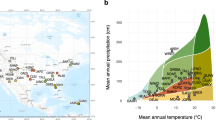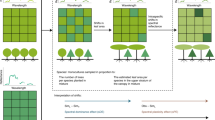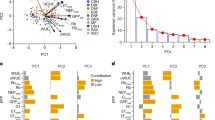Abstract
Biodiversity promotes ecosystem function as a consequence of functional differences among organisms that enable resource partitioning and facilitation. As the need for biodiversity assessments increases in the face of accelerated global change, novel approaches that are rapid, repeatable and scalable are critical, especially in ecosystems for which information about species identity and the number of species is difficult to acquire. Here, we present 'spectral diversity'—a spectroscopic index of the variability of electromagnetic radiation reflected from plants measured in the visible, near-infrared and short-wave infrared regions (400–2,400 nm). Using data collected from the Cedar Creek biodiversity experiment (Minnesota, USA), we provide evidence that the dissimilarity of species' leaf spectra increases with functional dissimilarity and evolutionary divergence time. Spectral diversity at the leaf level explains 51% of total variation in productivity—a proportion comparable to taxonomic (47%), functional (51%) or phylogenetic diversity (48%)—and performs similarly when calculated from high-resolution canopy image spectra. Spectral diversity is an emerging dimension of plant biodiversity that integrates trait variation within and across species even in the absence of taxonomic, functional, phylogenetic or abundance information, and has the potential to transform biodiversity assessment because of its scalability to remote sensing.
This is a preview of subscription content, access via your institution
Access options
Access Nature and 54 other Nature Portfolio journals
Get Nature+, our best-value online-access subscription
$29.99 / 30 days
cancel any time
Subscribe to this journal
Receive 12 digital issues and online access to articles
$119.00 per year
only $9.92 per issue
Buy this article
- Purchase on Springer Link
- Instant access to full article PDF
Prices may be subject to local taxes which are calculated during checkout



Similar content being viewed by others
References
Anderson, S. et al. State of the World’s Plants 2016 (Royal Botanic Gardens, Kew, 2016).
Ten Brink, P. et al. in The Cost of Policy Inaction: The Case of Not Meeting the 2010 Biodiversity Target (eds Braat, L. & Ten Brink, P.) Ch. 6 (Alterra, Wageningen, 2008).
Cardinale, B. J. et al. Biodiversity loss and its impact on humanity. Nature 486, 59–67 (2012).
Isbell, F. et al. Biodiversity increases the resistance of ecosystem productivity to climate extremes. Nature 526, 574–577 (2015).
Tilman, D., Lehman, C. L. & Bristow, C. E. Diversity–stability relationships: statistical inevitability or ecological consequence? Am. Nat. 151, 277–282 (1998).
Hector, A. et al. General stabilizing effects of plant diversity on grassland productivity through population asynchrony and overyielding. Ecology 91, 2213–2220 (2010).
Tilman, D. et al. The influence of functional diversity and composition on ecosystem processes. Science 277, 1300–1302 (1997).
Dı́az, S. & Cabido, M. Vive la difference: plant functional diversity matters to ecosystem processes. Trends Ecol. Evol. 16, 646–655 (2001).
Williams, L. J., Paquette, A., Cavender-Bares, J., Messier, C. & Reich, P. B. Spatial complementarity in tree crowns explains overyielding in species mixtures. Nat. Ecol. Evol. 1, 0063 (2017).
Wright, A., Schnitzer, S. A. & Reich, P. B. Living close to your neighbors: the importance of both competition and facilitation in plant communities. Ecology 95, 2213–2223 (2014).
Fargione, J. et al. From selection to complementarity: shifts in the causes of biodiversity–productivity relationships in a long-term biodiversity experiment. Proc. R. Soc. B 274, 871–876 (2007).
Cadotte, M. W. Functional traits explain ecosystem function through opposing mechanisms. Ecol. Lett. 20, 989–996 (2017).
Kraft, N. J., Godoy, O. & Levine, J. M. Plant functional traits and the multidimensional nature of species coexistence. Proc. Natl Acad. Sci. USA 112, 797–802 (2015).
Zuppinger-Dingley, D. et al. Selection for niche differentiation in plant communities increases biodiversity effects. Nature 515, 108–111 (2014).
Petchey, O. L., Hector, A. & Gaston, K. J. How do different measures of functional diversity perform? Ecology 85, 847–857 (2004).
Laliberté, E. & Legendre, P. A distance‐based framework for measuring functional diversity from multiple traits. Ecology 91, 299–305 (2010).
Wright, I. J. et al. The worldwide leaf economics spectrum. Nature 428, 821–827 (2004).
Adler, P. B., Fajardo, A., Kleinhesselink, A. R. & Kraft, N. J. Trait‐based tests of coexistence mechanisms. Ecol. Lett. 16, 1294–1306 (2013).
Maherali, H. & Klironomos, J. N. Influence of phylogeny on fungal community assembly and ecosystem functioning. Science 316, 1746–1748 (2007).
Cadotte, M. W., Cardinale, B. J. & Oakley, T. H. Evolutionary history and the effect of biodiversity on plant productivity. Proc. Natl Acad. Sci. USA 105, 17012–17017 (2008).
Felsenstein, J. Phylogenies and the comparative method. Am. Nat. 125, 1–15 (1985).
Losos, J. B. Phylogenetic niche conservatism, phylogenetic signal and the relationship between phylogenetic relatedness and ecological similarity among species. Ecol. Lett. 11, 995–1003 (2008).
Gravel, D. et al. Phylogenetic constraints on ecosystem functioning. Nat. Commun. 3, 1117 (2012).
Ackerly, D. D. Community assembly, niche conservatism, and adaptive evolution in changing environments. Int. J. Plant Sci. 164, S165–S184 (2003).
Cavender-Bares, J., Ackerly, D., Baum, D. & Bazzaz, F. Phylogenetic overdispersion in Floridian oak communities. Am. Nat. 163, 823–843 (2004).
Bolnick, D. I. et al. Why intraspecific trait variation matters in community ecology. Trends Ecol. Evol. 26, 183–192 (2011).
Violle, C. et al. The return of the variance: intraspecific variability in community ecology. Trends Ecol. Evol. 27, 244–252 (2012).
Siefert, A. et al. A global meta‐analysis of the relative extent of intraspecific trait variation in plant communities. Ecol. Lett. 18, 1406–1419 (2015).
Ustin, S. L. et al. Retrieval of foliar information about plant pigment systems from high resolution spectroscopy. Remote Sens. Environ. 113, S67–S77 (2009).
Curran, P. J. Remote sensing of foliar chemistry. Remote Sens. Environ. 30, 271–278 (1989).
Jacquemoud, S. & Baret, F. PROSPECT: a model of leaf optical properties spectra. Remote Sens. Environ. 34, 75–91 (1990).
Ollinger, S. V. Sources of variability in canopy reflectance and the convergent properties of plants. New Phytol. 189, 375–394 (2011).
Asner, G. P. & Martin, R. E. Airborne spectranomics: mapping canopy chemical and taxonomic diversity in tropical forests. Front. Ecol. Environ. 7, 269–276 (2008).
Rocchini, D. et al. Remotely sensed spectral heterogeneity as a proxy of species diversity: recent advances and open challenges. Ecol. Informatics 5, 318–329 (2010).
Ustin, S. L. & Gamon, J. A. Remote sensing of plant functional types. New Phytol. 186, 795–816 (2010).
Reich, P. B. et al. Impacts of biodiversity loss escalate through time as redundancy fades. Science 336, 589–592 (2012).
Gamon, J. A., Cheng, Y., Claudio, H., MacKinney, L. & Sims, D. A. A mobile tram system for systematic sampling of ecosystem optical properties. Remote Sens. Environ. 103, 246–254 (2006).
Wang, R.., Gamon, J. A.., Cavender-Bares, J.., Townsend, P. A.., & Zygielbaum, A. I.. The spatial sensitivity of the spectral diversity-biodiversity relationship: an experimental test in a prairie grassland. Ecol. Appl. 28, 541–556 (2018).
Davies, T. J., Urban, M. C., Rayfield, B., Cadotte, M. W. & Peres‐Neto, P. R. Deconstructing the relationships between phylogenetic diversity and ecology: a case study on ecosystem functioning. Ecology 97, 2212–2222 (2016).
Scheiner, S. M.., Kosman, E.., Presley, S. J.., & Willig, M. R.. Decomposing functional diversity. Methods Ecol. Evol. 8, 809–820 (2017).
McManus, K. M. et al. Phylogenetic structure of foliar spectral traits in tropical forest canopies. Remote Sens. 8, 196 (2016).
Cavender-Bares, J. et al. Associations of leaf spectra with genetic and phylogenetic variation in oaks: prospects for remote detection of biodiversity. Remote Sens. 8, 221 (2016).
Sims, D. A. & Gamon, J. A. Relationships between leaf pigment content and spectral reflectance across a wide range of species, leaf structures and developmental stages. Remote Sens. Environ. 81, 337–354 (2002).
Cavender-Bares, J. et al. Harnessing plant spectra to integrate the biodiversity sciences across biological and spatial scales. Am. J. Bot. 104, 966–969 (2017).
Cadotte, M. W., Cavender-Bares, J., Tilman, D. & Oakley, T. H. Using phylogenetic, functional and trait diversity to understand patterns of plant community productivity. PLoS ONE 4, e5695 (2009).
Serbin, S. P., Singh, A., McNeil, B. E., Kingdon, C. C. & Townsend, P. A. Spectroscopic determination of leaf morphological and biochemical traits for northern temperate and boreal tree species. Ecol. Appl. 24, 1651–1669 (2014).
Kokaly, R. F. & Clark, R. N. Spectroscopic determination of leaf biochemistry using band-depth analysis of absorption features and stepwise multiple linear regression. Remote Sens. Environ. 67, 267–287 (1999).
Madritch, M. D. et al. Imaging spectroscopy links aspen genotype with below-ground processes at landscape scales. Phil. Trans. R. Soc. B 369, 20130194 (2014).
Kothari, S. et al. Community-wide consequences of variation in photoprotective physiology among prairie plants. Photosynthetica 56, 455–467 (2018).
Townsend, P. A.., Serbin, S. P.., Kruger, E. L.., & Gamon, J. A.. Disentangling the contribution of biological and physical properties of leaves and canopies in imaging spectroscopy data. Proc. Natl Acad. Sci. USA 110, E1074 (2013).
Meireles, J. E., Schweiger, A. K. & Cavender-Bares, J. spectrolab: class and methods for hyperspectral data R package version 0.0.2 (2017); https://CRAN.R-project.org/package=spectrolab
R Development Core Team R: A Language and Environment for Statistical Computing (R Foundation for Statistical Computing, Vienna, 2016).
Wold, S., Martens, H. & Wold, H. in Matrix Pencils (Lecture Notes in Mathematics) (eds Ruhe, A. & Kagstrom, B.) 286–293 (Springer, Heidelberg, 1983).
Gilmore, A. M. & Yamamoto, H. Y. Resolution of lutein and zeaxanthin using a non-endcapped, lightly carbon-loaded C18 high-performance liquid chromatographic column. J. Chromatogr. A 543, 137–145 (1991).
Quach, H. T., Steeper, R. L. & Griffin, G. W. An improved method for the extraction and thin-layer chromatography of chlorophyll a and b from spinach. J. Chem. Educ. 81, 385 (2004).
Watanabe, T. et al. Preparation of chlorophylls and pheophytins by isocratic liquid chromatography. Anal. Chem. 56, 251–256 (1984).
Zieger, R., & Egle, K. Zur quantitativen Analyse der Chloroplasten Pigmente. I. Kritische Überprüfung derspektralphotometrischen Chlorophyllbestimmung. Beitr. Biol. Pflanz 41, 11–37 (1965).
Hiyama, T., Nishimura, M. & Chance, B. Determination of carotenes by thin-layer chromatography. Anal. Biochem. 29, 339–342 (1969).
Aasen, A. & Jensen, S. L. Carotenoids of flexibacteria. IV. The carotenoids of two further pigment types. Acta Chem. Scand. 20, 2322–2324 (1966).
De las Rivas, J., Abadía, A. & Abadía, J. A new reversed phase-HPLC method resolving all major higher plant photosynthetic pigments. Plant Physiol. 91, 190–192 (1989).
Bertrand, F., Meyer, N. & Maumy-Bertrand, M. Partial least squares regression for generalized linear models R package version 1.1.1 (2014); https://CRAN.R-project.org/package=plsRglm
Paradis, E., Claude, J. & Strimmer, K. APE: analyses of phylogenetics and evolution in R language. Bioinformatics 20, 289–290 (2004).
Dray, S. & Dufour, A.-B. The ade4 package: implementing the duality diagram for ecologists. J. Stat. Softw. 22, 1–20 (2007).
Oksanen, J. et al. vegan: community ecology package R package version 2.4-1 (2016); https://CRAN.R-project.org/package=vegan
Laliberté, E., Legendre, P., Shipley, B. & Laliberté, M. E. FD: measuring functional diversity from multiple traits, and other tools for functional ecology R package version 1.0-12 (2010); https://CRAN.R-project.org/package=FD
Acknowledgements
We acknowledge B. Fredericksen for help with leaf-level sampling, HPLC and proof reading, I. Carriere for leaf-level sampling, C. Nguyen for chemical assays and HPLC, S. Kothari for carbon fraction analysis, H. Gholizadeh and B. Leavitt for curating the tram data, and M. Kaproth and E. Murdock for proof reading. Funding was provided by the National Science Foundation and National Aeronautics and Space Administration through the Dimensions of Biodiversity programme (DEB-1342872 grant to J.C.-B. and S.E.H., DEB-1342778 grant to P.A.T., DEB-1342827 grant to M.D.M., DEB-1342823 grant to J.A.G.), the Cedar Creek National Science Foundation Long-Term Ecological Research programme (DEB-1234162), iCORE/AITF (G224150012 and 200700172), NSERC (RGPIN-2015-05129), and CFI (26793) grants to J.A.G., and a China Scholarship Council fellowship to R.W.
Author information
Authors and Affiliations
Contributions
This work is part of the Dimensions of Biodiversity project 'Linking remotely sensed optical diversity to genetic, phylogenetic and functional diversity to predict ecosystem processes', conceptualized by J.C.-B., P.A.T., S.E.H., M.D.M. and J.A.G. D.T. designed the Cedar Creek biodiversity experiment and advised on the project design. A.K.S. planned and conducted the data collection with input from J.C.-B., P.A.T. and J.A.G. J.A.G. designed the spectral tram and collected the tram data jointly with R.W. A.K.S. led the chemical analysis. A.K.S. analysed and interpreted the data with input from J.C.-B. A.K.S. wrote the manuscript. J.C.-B. edited the manuscript. P.A.T., S.E.H., M.D.M., D.T. and J.A.G. provided input to the manuscript at various stages.
Corresponding authors
Ethics declarations
Competing interests
The authors declare no competing interests.
Additional information
Publisher's note: Springer Nature remains neutral with regard to jurisdictional claims in published maps and institutional affiliations.
Supplementary information
Supplementary Information
Supplementary Methods, Supplementary Figures 1–10, Supplementary Tables 1–3, Supplementary References
Rights and permissions
About this article
Cite this article
Schweiger, A.K., Cavender-Bares, J., Townsend, P.A. et al. Plant spectral diversity integrates functional and phylogenetic components of biodiversity and predicts ecosystem function. Nat Ecol Evol 2, 976–982 (2018). https://doi.org/10.1038/s41559-018-0551-1
Received:
Accepted:
Published:
Issue Date:
DOI: https://doi.org/10.1038/s41559-018-0551-1
This article is cited by
-
An intermediate level of disturbance with customary agricultural practices increases species diversity in Maya community forests in Belize
Communications Earth & Environment (2023)
-
Joint multivariate and functional modeling for plant traits and reflectances
Environmental and Ecological Statistics (2023)
-
Quantifying the impacts of an invasive weed on habitat quality and prey availability for tiger snakes (Notechis scutatus) in urban wetlands
Wetlands Ecology and Management (2023)
-
Improved retrieval of phylogenetic signals from normalized foliar reflectance spectra in Neotropical forest gaps
Community Ecology (2023)
-
DNA barcoding, an effective tool for species identification: a review
Molecular Biology Reports (2023)



